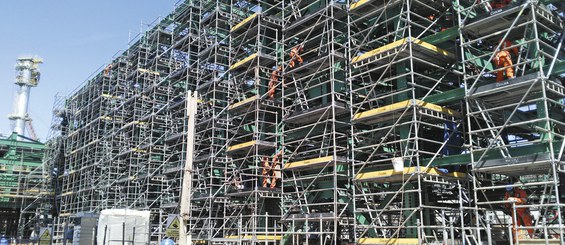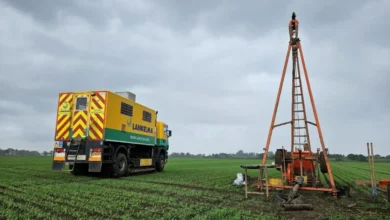Industrial Scaffolding: Applications and Benefits in Diverse Environments

Industrial scaffolding plays a pivotal role in various sectors, providing essential support for maintenance, construction, and repair tasks in environments that range from oil and gas facilities to chemical plants and industrial mills. This blog explores the importance of scaffolding in these specialized settings, highlighting its applications, benefits, and specific considerations.
Importance of Industrial Scaffolding
Industrial facilities, such as oil refineries, chemical plants, and manufacturing mills, often feature complex structures and equipment that require regular inspection, maintenance, and sometimes construction work. Industrial scaffolding serves as a crucial tool in these environments by:
- Providing Access: Enables workers to reach elevated areas safely and efficiently.
- Supporting Heavy Loads: Capable of bearing substantial weights for equipment and personnel.
- Ensuring Safety: Offers stable platforms with guardrails and other safety features to protect workers.
- Facilitating Efficiency: Allows simultaneous work on multiple levels or areas, optimizing project timelines.
Types of Industrial Environments Using Scaffolding1. Oil and Gas Facilities
Description: Oil refineries, offshore platforms, and gas processing plants require scaffolding for routine maintenance, inspections, and occasional construction projects.
Applications:
- Maintenance: Accessing and maintaining equipment such as towers, vessels, and pipelines.
- Turnaround Projects: Large-scale maintenance overhauls during shutdown periods.
- New Construction: Supporting structures for expansions or upgrades.
Considerations:
- Corrosion Resistance: Scaffolding materials must withstand corrosive environments.
- Safety Standards: Compliance with stringent safety regulations due to hazardous materials and conditions.
- Accessibility: Ability to set up scaffolding on uneven or offshore platforms.
2. Chemical Plants
Description: Chemical manufacturing facilities utilize scaffolding for maintenance of reactors, storage tanks, and piping systems.
Applications:
- Equipment Maintenance: Inspections, repairs, and replacements of critical infrastructure.
- Shutdown Projects: Overhauling operations during planned shutdowns.
- Safety Access: Providing safe access to high-risk areas where chemicals are processed.
Considerations:
- Material Compatibility: Scaffolding components resistant to chemical exposure.
- Environmental Controls: Managing scaffolding in potentially hazardous atmospheres.
- Workload Capacity: Handling heavy tools and equipment typical in chemical plant operations.
3. Industrial Mills (Steel, Paper, etc.)
Description: Steel mills, paper mills, and other manufacturing plants use scaffolding for maintenance of machinery, boilers, and furnace structures.
Applications:
- Maintenance: Accessing and repairing heavy machinery and industrial equipment.
- Construction Projects: Supporting new installations or modifications to existing structures.
- Emergency Repairs: Responding quickly to equipment failures to minimize downtime.
Considerations:
- High Temperatures: Scaffolding materials capable of withstanding heat and thermal stress.
- Structural Integrity: Ensuring scaffolding can support the weight of industrial equipment and materials.
- Accessibility: Maneuverability in confined spaces and around large equipment.
4. Power Plants
Description: Power generation facilities, including nuclear, coal, and renewable energy plants, rely on scaffolding for maintenance and construction projects.
Applications:
- Inspections and Repairs: Accessing turbines, boilers, and cooling towers for maintenance.
- Plant Upgrades: Installing new equipment and retrofitting existing infrastructure.
- Safety Access: Providing safe platforms for working at height near electrical systems.
Considerations:
- Radiation Protection: Scaffolding materials suitable for radiation environments in nuclear plants.
- Electrical Hazards: Ensuring scaffolding does not interfere with electrical systems or create hazards.
- Environmental Impact: Minimizing disruption to ongoing operations during maintenance.
Benefits of Industrial Scaffolding1. Safety
Industrial scaffolding incorporates safety features such as guardrails, toe boards, and sturdy platforms, ensuring a safe working environment for personnel operating at heights or in hazardous conditions.
2. Efficiency
By providing access to multiple levels and areas simultaneously, industrial scaffolding allows for efficient completion of maintenance tasks, reducing downtime and optimizing operational schedules.
3. Versatility
Various types of scaffolding systems can be adapted to different industrial environments and project requirements, offering flexibility in configuration and setup.
4. Cost-effectiveness
Despite initial setup costs, industrial scaffolding proves cost-effective over time by facilitating faster project completion, minimizing downtime, and reducing the need for alternative access methods.
Challenges and Considerations1. Environmental Conditions
Industrial scaffolding must withstand harsh environmental conditions, including extreme temperatures, corrosive substances, and potentially explosive atmospheres.
2. Regulatory Compliance
Adherence to stringent safety and environmental regulations is essential in industrial settings, requiring scaffolding designs and practices that meet regulatory standards.
3. Complexity of Projects
Some industrial projects involve intricate structures and equipment configurations, necessitating customized scaffolding solutions and specialized engineering assessments.
Conclusion
Industrial scaffolding plays a vital role across a diverse range of industrial environments, supporting maintenance, construction, and repair activities with safety, efficiency, and adaptability. Whether in oil and gas facilities, chemical plants, industrial mills, or power generation plants, scaffolding systems enable safe access to elevated areas and ensure the smooth operation of critical infrastructure. Understanding the specific requirements and challenges of each industrial sector is crucial for selecting the appropriate scaffolding solution and maintaining high standards of safety and efficiency in industrial operations. As technology and safety standards evolve, industrial scaffolding continues to evolve as an indispensable tool in industrial maintenance and construction practices worldwide.



